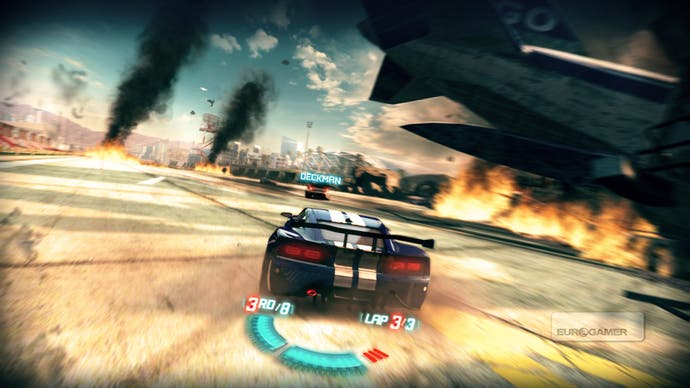Split/Second: Velocity Multiplayer
Spend a little time together.
I'm on the train home from Disney's London offices and I'm wondering whether Black Rock has overdone the realism of Split/Second's crashes a little bit.
Not because they look weird (they look amazing) and not because there's anything wrong with the physics (there isn't). More because my neck is sore from leaning into corners like a 12-year-old playing Mario Kart, my throat hurts from shouting at the people I've been playing it with, and I've got a nasty friction burn across my collarbone. No idea about that one actually.
Plus, of course, I'm on a shaky comedown from all the adrenaline. The last couple of hours have been filled with explosions, hair's-breadth escapes and aggressive racing-line ownerships. It's exhausting stuff, and the physical toll it's taken on me is more a testament to the nature of the game than it is to my poor fitness.
You've probably played a bit of the demo by now, and the chances are you enjoyed it, but dumping a huge quantity of reinforced concrete onto the bonnets of some AI cars is nowhere near as satisfying as ruining real-life opposition.
Split/Second's vehicles, broadly split into three categories of truck, muscle and sport, have a tremendous sense of weight, and because of this they have genuine impact in the frequent and satisfying collisions. They're low-slung, stylish and predatory, emphasising the very tactile arcade driving model as well as the aggressive nature of the game.

We're given three choices to play with during our session, one from each class, designed to highlight the pros and cons for each of the three multiplayer modes of race, elimination and survival.
Race is self-explanatory. Played online or in split-screen, these are battles between eight cars on any of the unlocked tracks, of which we were exposed to around 16.
They're as straightforward as racing gets in Split/Second, which is actually to say 'not very'. Routes and shortcuts change on almost every lap - disorientating for the first couple of races, but thoroughly enjoyable thereafter - while explosions, rock-slides and renegade cross-channel ferries punctuate every other corner. As a result the grid stays pretty fluid, with a well-timed powerplay easily dropping you four or five places.
There's almost always a chance to dodge the more serious obstacles which suddenly drop into your path, however, alleviating the frustration of unavoidable sudden death.

The reasons for this are twofold. First, powerplays take some timing to pull off. The icons that appear above other racers' heads to signify that a powerplay is available are visible for a second or two on each side of the actual window of opportunity, meaning that laggardly or overenthusiastic use will miss your intended target. Second, because powerplays trigger events rather than weapons their consequences can often be avoided with quick reactions and a bit of driving nous.
Even in the most hectic of races you rarely feel hard done by. Seeing a crane swing the engine block of a 747 across your path, eliminating the frontrunners and elevating you to first, does feel a bit like cheating, but only in the most delicious of ways.




